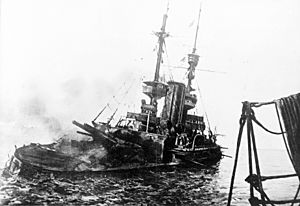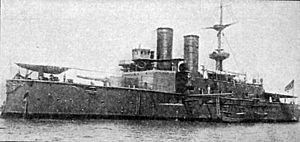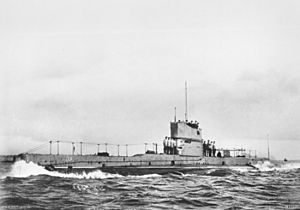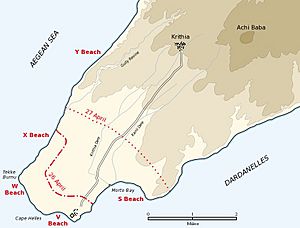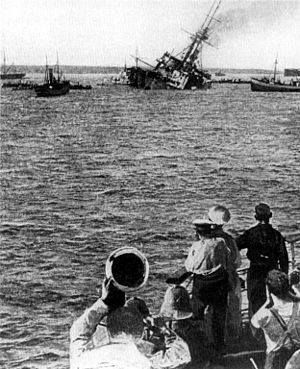Naval operations in the Dardanelles campaign facts for kids
The naval operations in the Dardanelles campaign (February 1915 – January 1916) were a series of sea battles during First World War. Ships from the Royal Navy (Britain), the French Navy, the Russian Navy, and the Royal Australian Navy tried to force their way through the Dardanelles Straits. This narrow waterway connects the Mediterranean Sea to the Sea of Marmara and the Black Sea.
The Ottoman Empire defended the straits with forts and many naval mines. These defenses stopped the Allied ships from getting through. Because of this, the Allies launched an invasion of the Gallipoli peninsula. Their goal was to remove the Ottoman artillery (big guns) that were protecting the straits. Allied submarines also tried to sneak through the Dardanelles to attack Ottoman ships in the Sea of Marmara.
Quick facts for kids Naval operations in the Dardanelles campaign |
|||||||
|---|---|---|---|---|---|---|---|
| Part of the Gallipoli campaign | |||||||
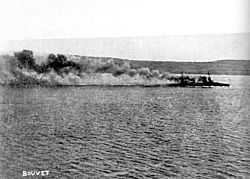 The final moments of the French battleship Bouvet, 18 March 1915 |
|||||||
|
|||||||
| Belligerents | |||||||
| Commanders and leaders | |||||||
| Sackville Carden John de Robeck Roger Keyes Émile Gaépratte |
Cevat Çobanlı Liman von Sanders |
||||||
| Strength | |||||||
| 1 super dreadnought 3 battlecruisers 28 pre-dreadnoughts 23 cruisers 25 destroyers 13 submarines 1 seaplane carrier |
Various mines and forts 2 pre-dreadnoughts Minelayers 1 coastal defence ship 1 battlecruiser 3 cruisers 2 torpedo cruisers 8 destroyers |
||||||
| Casualties and losses | |||||||
| 1 battlecruiser heavily damaged 3 pre-dreadnoughts sunk 3 pre-dreadnoughts heavily damaged 1 cruiser damaged 700 killed (ship complements on March 18) |
1 minelayer 1 pre-dreadnought sunk 1 coastal defence ship sunk 1 cruiser sunk 1 torpedo cruiser damaged 40 killed 78 wounded (on land, 18 March) |
||||||
Contents
Background to the Conflict
The Dardanelles Strait
The Dardanelles Strait is a narrow waterway. It is about 41 miles (66 km) long. It connects the Aegean Sea to the Sea of Marmara and then to the Black Sea. The entrance to the strait is about 2.3 miles (3.7 km) wide.
The land on both sides of the strait was important. The Gallipoli peninsula was on one side. Lower hills were on the Asian side. The Ottoman Empire had built many forts along the strait. These forts had guns to protect the waterway.
Ottoman Empire Joins the War
At the start of the 20th century, the Ottoman Empire was not as strong as it once was. In 1914, Germany sent military advisors to help the Ottoman army. The Ottoman leaders secretly agreed to an alliance with Germany against Russia.
Britain had been building two modern battleships for the Ottoman Navy. But Britain took these ships for its own navy. This made the Ottomans angry. Germany then offered two of its own ships, SMS Goeben and SMS Breslau, as replacements. These German ships sailed to the Dardanelles. The Ottoman government let them through, even though it was supposed to be neutral. This showed they were leaning towards Germany.
Dardanelles Closed to Allies
In October 1914, the Dardanelles Strait was closed. This happened after a small incident with a British ship. The German commander of the Dardanelles forts ordered the closure. This made it clear the Ottomans were supporting Germany.
On October 28, the Ottoman fleet, including the German ships, attacked Russian ports. Russia declared war on Turkey on November 2. Britain and France declared war on November 5. A British naval squadron then attacked some Ottoman forts at the entrance of the Dardanelles. This attack destroyed a fort and killed many soldiers. The Ottomans realized they needed to strengthen their defenses even more.
Preparing for Battle
Allied Plans
By late 1914, the war on the Western Front was stuck. Trade routes to Russia were blocked. The Dardanelles was the last way to send supplies to Russia. Russia asked Britain for help against the Ottomans.
Winston Churchill, who was in charge of the British Navy, suggested attacking the Dardanelles. He believed it would open a supply route to Russia. It might also encourage countries like Bulgaria and Romania to join the Allies.
In January 1915, a British admiral named S. H. Carden proposed a plan. He wanted to use battleships and minesweepers to force through the Dardanelles. The British War Council approved this plan. More battleships were sent, including the powerful HMS Queen Elizabeth. France and Russia also sent ships. Soldiers were also gathered in Egypt. They were meant to capture Constantinople (Istanbul) after the navy cleared the straits.
Ottoman Defenses
In 1914, the Ottoman defenses were not very strong. Many of their guns were old. They also had little ammunition. German advisors helped the Ottomans improve their defenses. They focused on protecting the minefields.
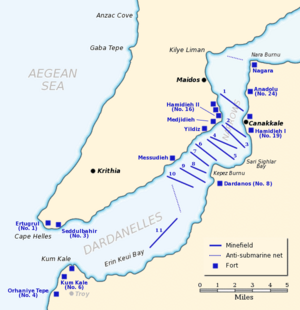
By March 1915, the Ottomans had laid ten lines of mines. They also had 12 searchlights to spot enemy ships at night. The short British bombardment on November 3, 1914, had shown the Ottomans their weaknesses. It made them work harder to improve their defenses. They repaired the damaged forts and focused on protecting the inner parts of the strait.
First Attempts to Force the Straits
On November 3, 1914, British and French ships attacked the Dardanelles. This was before a formal declaration of war. The attack was to test the Ottoman defenses. One shell hit a fort's ammunition storage, killing 86 Ottoman soldiers. This attack made the Ottomans lay even more mines.
On February 19, 1915, the Allies attacked again. The battleships HMS Cornwallis and Vengeance fired at the forts. The long-range firing did not do much damage. Ships needed to get closer to hit the guns directly.
On February 25, the Ottomans left the outer defenses. Allied ships entered the straits. But clearing the minefields was very difficult. The minesweepers were civilian fishing boats. Their crews did not want to work under fire. The strong current in the strait also made sweeping mines hard.
On March 13, the cruiser HMS Amethyst led six minesweepers. They tried to clear mines at night. Four of the minesweepers were hit. Amethyst was badly damaged, and 19 crew members were killed.
The Big Battle of March 18
The most important event happened on the night of March 18. The Ottoman minelayer Nusret secretly laid a new line of 20 mines. These mines were placed in Eren Köy Bay, where Allied ships often turned. The British and French did not know about these new mines.
The Allied plan for March 18 was to silence the forts. Then, minesweepers would clear the first five minefields. The next day, they would clear the rest. The battle started around 11:00 AM. British and French ships fired at the forts. Some Allied ships were hit.
| Line A | HMS Queen Elizabeth | Agamemnon | Lord Nelson | Inflexible |
|---|---|---|---|---|
| French Line B | Gaulois | Charlemagne | Bouvet | Suffren |
| British Line B | HMS Vengeance | Irresistible | Albion | Ocean |
| Supporting ships | HMS Majestic | Prince George | Swiftsure | Triumph |
| Reserve | HMS Canopus | Cornwallis |
Around 1:54 PM, the French battleship Bouvet turned into Eren Köy Bay. It hit a mine and sank in minutes. 639 crew members died. The British battlecruiser Inflexible also hit a mine and was badly damaged. Then, the battleships Irresistible and Ocean also hit mines and sank.
The Allies lost three battleships and had three more badly damaged. The Ottomans lost very few men. After this defeat, the Allied naval commanders decided that land forces were needed to capture the forts. This led to the Gallipoli campaign starting on April 25.
Submarine Operations
British submarines tried to enter the Dardanelles even before the main campaign. On December 13, 1914, HMS B11 entered the straits. It avoided five lines of mines. It then torpedoed the Ottoman battleship Mesûdiye. This old battleship was being used as a floating fort. Mesûdiye sank in ten minutes. This was a big success for the British Navy.
The first submarine to successfully pass through the straits was the Australian HMAS AE2. It got through on the night of April 24/25, 1915. AE2 sank one Ottoman destroyer. However, it was later sunk by an Ottoman torpedo boat. The crew was captured.
Another British submarine, HMS E14, had more success. It entered the Sea of Marmara on April 27. It spent three weeks attacking Ottoman shipping. This caused big problems for Ottoman supplies and morale. The captain of E14 was awarded a special medal for his bravery.
Submarines continued to operate in the Sea of Marmara. They sank many Ottoman transport ships. This forced the Ottomans to stop using the sea for transport. Between April and December 1915, Allied submarines sank many ships. They lost eight of their own submarines in the process.
Landings at Gallipoli
Troops Land on the Peninsula
After the naval attack failed, the Allies decided to use soldiers. Their goal was to capture the Gallipoli peninsula. This would allow the navy to pass through the Dardanelles. Preparations for the landing took a month. This gave the Ottoman defenders time to get ready.
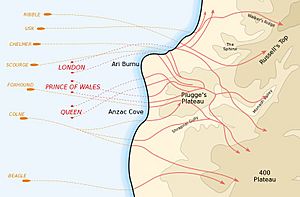
The main landings happened on April 25, 1915. Australian and New Zealand soldiers (Anzacs) landed at a place now called Anzac Cove. British soldiers landed at Cape Helles. Warships supported the landings by firing their guns.
Naval guns were used to support the soldiers on land. They acted like artillery. Sometimes, these big guns were very effective. For example, on April 27, Queen Elizabeth fired shells at Ottoman soldiers. This stopped their attack.
In May, the Allies started losing battleships to Ottoman torpedo boats and German submarines. The battleship Goliath was sunk on May 12. Then, the German submarine U-21 sank Triumph on May 25 and Majestic on May 27.
Because of these losses, valuable battleships like Queen Elizabeth were pulled out. Instead, cruisers, destroyers, and special ships called monitors provided artillery support. These ships were designed for coastal bombardment. Once the navy became more careful about submarines, their losses stopped.
Transporting Troops
Another important job for the Allied navy was transporting thousands of soldiers. They moved troops to and from the Dardanelles across the Mediterranean Sea. The biggest dangers were German and Austrian submarines and mines.
The worst loss during the campaign was the sinking of HMT Royal Edward. On August 13, 1915, this troopship was torpedoed by a German submarine. 935 lives were lost.
End of the Campaign
After the land campaign also struggled, some leaders wanted to try another naval attack. But others, especially in the British Navy, were against it. They worried about losing more ships. This disagreement led to changes in the British government.
By December 1915, it was decided to abandon the entire campaign. The Allied forces began to withdraw their troops. The Dardanelles campaign ended in a defeat for the Allies.
See also
- Pursuit of Goeben and Breslau
- List of Allied warships that served at Gallipoli
- All the King's Men (1999 film)
- Coastal artillery of the Dardanelles Strait





